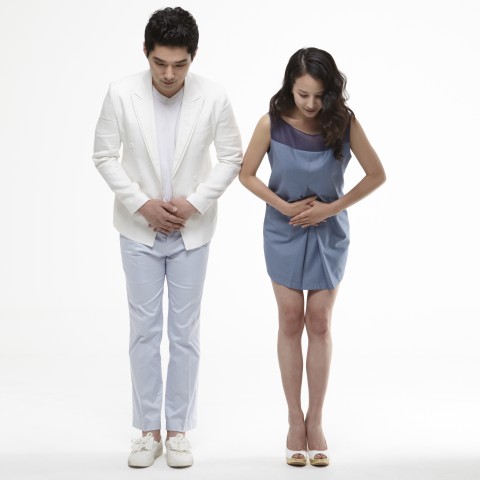When it comes to learning a new language, “hello” is the first word you learn. As the majority of language learners will agree, you’ll come to realize how many different ways there are to say hello in other languages, although you’re already using various greetings in your own language.
Today, KoreanClass101 is going to introduce you to eighteen Korean greetings, both informal and formal. Let’s go through them one-by-one, so that you know exactly when to use these greetings next time you chat with your Korean friends. We hope you get the most from this Korean greetings guide!
1. How to Say Hello in Korean: 4 Must-Know Greetings
These four common Korean greetings are used often in South Korea and you may already know some of them, but let’s go through them one-by-one to review anyway. If you’re an absolute beginner, it’s okay. These aren’t difficult to memorize.
1- 안녕 (Annyeong) — “Hello” (Informal)
안녕 (Annyeong) is a casual and friendly Korean greeting used among friends and people of the same age who know each other. You can also say Annyeong to people who are younger than you. It’s similar in meaning to “What’s up?” or “Hey” in English, and it’s a gender-neutral greeting. Remember that this casual greeting cannot be used to greet people of a higher status—such as a teacher or a boss—or to the strangers that you meet everyday.
Example: (A and B are friends)
※ Click on a word for pronunciation
A: 안녕
A: Annyeong
A: “Hello”
B: 어, 안녕
B: Eo, annyeong.
B: “Oh, hey”
2- 안녕하세요 (Annyeonghaseyo) — “Hello” (Formal)
Annyeonghaseyo is a formal Korean greeting used for everyday conversations, and can be used in the majority of situations. This greeting is used to greet any strangers that you meet such as a cashier at the supermarket as well as people who are older than you, such as older family members.
When you meet someone of the same age, you’ll need to greet them formally to show some respect. If you’re not sure whether to say hello in a formal or informal way, Annyeonghaseyo is safe to say.
Example: (A is a cashier and B is a buyer)
※ Click on a word for pronunciation
A: 안녕하세요, 봉투 필요하십니까?
A: Annyeonghaseyo, bongtu piryohasimnikka?
A: “Hello, would you like to have a plastic bag?”
B: 안녕하세요, 아니요 괜찮아요.
B: Annyeonghaseyo, aniyo gwaenchanayo.
B: “Hello, no thank you.”
3- 안녕하십니까 (Annyeonghasimnikka) — “Hello” (Formal, showing great respect)
안녕하십니까 (Annyeonghasimnikka) isn’t commonly used on a daily basis. However, if you work in Korea, you’ll notice that people use this formal greeting everyday. This formal Korean greeting is commonly used in a business setting.
Also, people who are serving in the military in Korea use this formal greeting every day, as they must use formal language.
Example: (A visits B’s office and they meet for the first time)
※ Click on a word for pronunciation
A: 안녕하십니까, 처음 뵙겠습니다. 마케팅 팀장 존이라고 합니다.
A: Annyeonghasimnikka, Cheoeum Boepgetseumnida. Maketing Timjang Jonirago Hamnida.
A: “How do you do, I’m John, the manager of Marketing team.”
B: 반갑습니다. 세일즈팀 팀장 이민호라고 합니다.
B: Bangapseumnida. Seiljeutim Timjang Iminhorago Hamnida.
B: “It’s a pleasure to meet you. I’m Lee Minho, the manager of Sales team.”
4- 안뇽 (Annyong); 하이 (Hai) — “Hello” (Slang words)
There are many ways to greet a friend in Korean while in South Korea, and this includes slang words, such as Annyong and Hai. 안뇽 (Annyong) is a slang word used to greet someone casually, and is usually used by women since it sounds feminine. 하이 (Hai), direct translation being “Hello” in English, is also a casual way to greet a friend.
You’ll hear these two greetings a lot in South Korea. In addition, Koreans also use other slang words such as 하이룽 (Hairung), 방가방가 (Banggabangga), and many more. Please note that you don’t need to memorize all the slang words to say hello in Korean. KoreanClass101 has a lesson that covers Korean slang words, so feel free to check it out.
Example: (A returns home from a trip and greets B who is her close friend)
※ Click on a word for pronunciation
A: 안뇽, 나 왔어.
A: Annyong, Na Wasseo.
A: “Hey, I’m home.”
B: 하이, 잘 갔다 왔어?
B: Hai, Jal gatda Wasseo?
B: “Hi, did you have fun?”
2. Meeting Someone for the First Time
When you meet someone for the first time, you need to be able to use appropriate Korean greeting phrases. You can definitely use one of the four must-know greetings mentioned above to greet someone depending on the age of the person you’re talking to, and the situation you’re in. Let’s learn what you can say after using these basic greetings to continue a conversation with this person.
1- 만나서 반가워 (mannaseo bangawo) (Informal); 만나서 반갑습니다 (mannaseo bangapseumnida) (Formal)
In English, this phrase is “Nice to meet you.”
Example:
※ Click on a word for pronunciation
안녕, 만나서 반가워.
안녕하세요, 만나서 반갑습니다.
2- 처음 뵙겠습니다. (cheoeum boepgetseumnida.) (Formal)
This is another way to say, “Nice to meet you,” in Korean, and the direct translation is “I am meeting you for the first time.” Remember that there’s no informal phrase for 처음 뵙겠습니다. (cheoeum boepgetseumnida.); this phrase is usually used to greet elders or for a more formal setting.
If you meet a person who’s older than you or who you met in a business setting, use this phrase instead of 처음 뵙겠습니다. (cheoeum boepgetseumnida.). Usually, (저는)000입니다 follows this phrase.
Example:
A: 처음 뵙겠습니다. 박소연입니다.
A: cheoeum boepgetseumnida. baksoyeonimnida.
A: “Nice to meet you. I’m Park Soyeon.”
3- 잘 부탁해 (jal butakae) (Informal); 잘 부탁드립니다. (jal butakdeurimnida) (Formal)
Many Korean learners become bewildered when they hear this phrase, because it sounds like the speaker is putting some pressure on the listener. This is because the literal translation is “Please take good care of me (or implied person).” However, this phrase actually has a slightly different meaning than what it first seems to mean.
The classical example of when to use this Korean greeting would be when a new employee starts his new job. On his first day, he closes his self-introduction with 잘 부탁드립니다. (jal butakdeurimnida). This doesn’t mean, “It’s my first day, so please take good care of me.” On the contrary, this is generally a way of saying, “I look forward to working with you,” or “I will do my best,” to his employees. Essentially, it’s an informal way to say 잘 부탁해 (jal butakae).
Example: (A and B are starting their jobs today)
A: 안녕하세요, 오늘부터 일하게 된 제이슨이라고 합니다. 잘 부탁드립니다.
A: annyeonghaseyo, oneulbuteo ilhage doen jeiseunirago hamnida. Jal butakdeurimnida.
A: “Hello, this is my first day at work and I am Jason. I am looking forward to working with you.”
B: 안녕하세요, 오늘부터 아르바이트 시작하게 된 브라이언이라고 합니다. 잘 부탁드립니다.
B: annyeonghaseyo, oneulbuteo areubaiteu sijakage doen beuraieonirago hamnida. Jal butakdeurimnida.
B: “Hello, this is my first day for my part-time job and I am Brian. I look forward to working with you.”
4- 저는 ~에서 온 A이라고 합니다.
In English, this is “I am A, from ~.” This Korean greeting phrase is commonly used to greet someone for the first time and when introducing yourself. Examples are written below.
Example:
A: 안녕하세요, 저는 미국에서 온 앨리스라고 합니다. 잘 부탁드립니다. (Formal)
A: annyeonghaseyo, jeoneun migugeseo on aelliseurago hamnida. Jal butakdeurimnida.
A: “Hello, my name is Alice, from America. I look forward to working with you.”
B: 안녕, 나는 서울대학교에서 온 김나영이라고 해. 잘 부탁해. (Informal)
B: annyeong, naneunseouldaehakgyoeseo on gimnayeongirago hae. Jalbutakae.
B: “Hi, I am Kim Nayoung, from Seoul University. I look forward to studying with you.”
There are many ways to say, “My name is…” in Korean including:
- (저의 이름은) A(이)라고 합니다. (Formal)
(jeoui ireumeun) A(i)rago hamnida. - (저의 이름은) A입니다. (Formal)
(jeoui ireumeun) A imnida. - (나의 이름은) A(이)라고 해 (Informal)
(naui ireumeun) A(i)rago hae - A(이)야 (Informal)
A(i)ya
In spoken language, we usually skip 나의 이름은/저의 이름은. This is the same as discarding “My name is” when introducing yourself in English.
3. How to Say “How Are You?” in Korean
There is a number of ways to say “How are you?” in Korean and each phrase has a slightly different meaning, so let’s go through them one-by-one and learn an appropriate situation to say each of these Korean greetings.
1- How are You Doing?
- 잘 지냈어? (jal jinaesseo?) (Informal)
- 잘 지내셨어요? (jal jinaesyeosseoyo?) (Formal)
This is the most-used “How are you?” phrase in Korea. It’s a simple and casual greeting and is a great way to start a conversation. Usually Koreans say 안녕 (Annyeong) or 안녕하세요 (Annyeonghaseyo), followed by 잘 지냈어? (jal jinaesseo?) or 잘 지내셨어요? (jal jinaesyeosseoyo?), so try to memorize it as a full sentence.
Example: (A and B are friends and A is younger than B)
A: 안녕하세요, 잘 지내셨어요? (Formal)
A: annyeonghaseyo, jal jinaesyeosseoyo?
A: “Hello, how are you doing?”
B: 어, 안녕. (진짜 오랜만이다.) 잘 지냈어?
B: eo, annyeong. (jinjja oraenmanida.) jal jinaesseo?
B: “Ah, hey. (Long time, no see.) How are you?”
2- What are You Doing These Days?
- 뭐하고 지내? (mwohago jinae?) (Informal)
- 어떻게 지내세요? (eotteoke jinaeseyo?) (Formal)
These phrases are used if you haven’t met with someone in a few days or more. If you’re curious to know what the person has been up to lately, use this phrase. Often they’ll talk about a current activity they’re doing, such as a new hobby or a project that the person has been working on at work lately.
Example: (A and B are friends; C and D are colleagues)
A: 요즘 뭐하고 지내?
A: Yojeum mwohago jinae?
A: “What are you doing these days?”
B: 나? 나야 뭐 항상 똑같지뭐.
B: Na? Naya mwo hangsang ttokgatjimwo.
B: “Me? It’s always the same.”
—
C: 요즘 어떻게 지내세요?
C: yojeum eotteoke jinaeseyo?
C: “What are you doing these days?”
D: 최근에 새로 시작한 마케팅 캠페인 때문에 정신이 없어요.
D: choegeune saero sijakan maketing kaempein ttaemune jeongsini eopseoyo.
D: “I have been really busy since I’ve just started working on a marketing campaign.”
3- What Have You Been Up To?
- 뭐하고 지냈어? (mwohago jinaesseo?) (Informal)
- 어떻게 지내셨어요? (eotteoke jinaesyeosseoyo?) (Formal)
Use these phrases if you haven’t seen someone for a long time (e.g. one year or more), and want to know everything about what that person has been up to. It’s a great Korean greeting phrase to use to catch up with someone.
Example:
A: 뭐하고 지냈어?
A: mwohago jinaesseo?
A: “What have you been up to?”
B: 음.. 사실 남자친구랑 헤어져서 맨날 집에서 시간 보내고 있어.
B: eum… sasil namjachingurang heeojyeoseo maennal jibeseo sigan bonaego isseo.
B: “Hmm… Actually I broke up with my ex-boyfriend so I have been just staying home.”
4- Long Time, No See
- 진짜 오랜만이다. (jinjja oraenmanida.) (Informal)
- 정말 오랜만이에요. (jeongmal oraenmanieyo.) (Formal)
Use this Korean phrase when you meet someone whom you haven’t met with for a long time and want to express how excited you are to meet them again.
Example: (A and B are friends; C and D are colleagues)
A: 우와, 진짜 오랜만이다.
A: uwa, jinjja oraenmanida.
A: “Wow, long time no see.”
B: 하하, 정말 반갑다야.
B: haha, jeongmal bangapdaya.
B: “Haha, it’s really nice to meet you again.”
—
C: 진짜 오랜만이에요. 잘 지내셨어요?
C: jinjja oraenmanieyo. Jal jinaesyeosseoyo?
C: “It’s been awhile, how are you doing?”
D: 응, 그럼. 잘 지내고 있지.
D: eung, geureom. Jal jinaego itji.
D: “Yes I am doing well.”
4. How to Say “Good morning” in Korean
1- Good Morning
- 좋은 아침이에요. (joeun achimieyo) (Formal)
- 좋은 아침 (joeun achim) (Informal)
- 굿모닝 (gunmoning) (Informal and casual greeting)
Example:
A: 좋은 아침!
A: joeun achim!
A: “Good morning!”
B: 굿모닝, 잘잤어?
B: gunmoning, jaljasseo?
B: “Good morning, did you sleep well?”
2- Did You Sleep Well?
- 안녕히 주무셨어요? (annyeonghi jumusyeosseoyo?) (Formal)
- 잘 잤어? (jal jasseo?) (Informal)
Example:
- 할머니, 안녕히 주무셨어요? (Formal)
halmeoni, annyeonghi jumusyeosseoyo?
“Grandmother, did you sleep well?” - 소연아 잘 잤어? (Informal)
soyeona jal jasseo?
“Did you sleep well, Soyeon?”
5. How to Say “Good Night” in Korean
1- Have a Good Sleep
- 안녕히 주무세요. (annyeonghi jumuseyo.) (Formal)
- 잘자 (jalja) (Informal)
안녕히 주무세요. (annyeonghi jumuseyo.) is a formal greeting to say “Good night” in Korean. Also, remember that bowing is very important in Korea. The appropriate way to say good night to the elders is to bow and say the greeting.
On the other hand, when you say good night to your friend, you don’t need to bow. Instead, you can just wave your hand or nod once at your friend. The gesture of nodding is a very common body language greeting among friends in Korea; just think of it as a casual way of bowing.
Example:
A: 너무 피곤해서 자야할 것 같습니다. 안녕히 주무세요. (Bow)
A: neomu pigonhaeseo jayahal geot gatseumnida. annyeonghi jumuseyo.
A: “I am exhausted, I think I should go to bed. Good night.”
B: 알겠어요. 푹 쉬세요.
B: algesseoyo. puk swiseyo.
B: “I understand, rest well.”
2- Good night
- 굿나잇 (gunnait) (Informal and casual friendly greeting)
- 굿밤 (gutbam) (Slang)
Simple English phrases are commonly used among younger people. Also, 굿밤 (gutbam) is a slang word that’s also used commonly by younger people as well.
6. How to Greet on the Phone
1- 여보세요. (yeoboseyo.)
This Korean greeting is to say “hello” when answering the phone. You’ll hear this all the time when you call someone on the phone. However, in a business setting, people usually address the name of the company, then the name. 여보세요. (yeoboseyo.) is rarely used in a business setting.
여보세요. (yeoboseyo.) also has another meaning; it’s used when you’re trying to get the attention of someone. However, it does portray a negative connotation, so try not to use this unless you want to initiate an argument.
Example: (A and B are friends; D is calling his friend and his mother, C, picked up the phone)
A: 여보세요.
A: yeoboseyo.
A: “Hello.”
B: 뭐해?
B: mwohae?
B: “What are you up to?”
—
C: 여보세요.
C: yeoboseyo.
C: “Hello.”
D: 안녕하세요, 지연이 친구인데요, 지연이 바꿔주실 수 있으세요?
D: annyeonghaseyo, jiyeoni chinguindeyo, jiyeoni bakkwojusil su isseuseyo?
D: “Hello, I’m a friend of Jiyeon, could you please put me through to Jiyeon?”
2- ~때문에 연락 드렸습니다. (~ttaemune yeollak deuryeotseumnida.) (Formal)
This Korean greeting phrase for answering the phone is usually used right after 안녕하세요 (Annyeonghaseyo) or 여보세요. (yeoboseyo.). It’s commonly used in a business setting. If you want to sound formal, you can say, 안녕하세요 (Annyeonghaseyo), ~때문에 연락 드렸습니다. (~ttaemune yeollak deuryeotseumnida.).
Also, you can use this phrase in any formal situation. If you want to sound less formal and more friendly with a casual phrase—let’s say you’re calling your friend—there’s an informal Korean phrase to use, which is ~때문에 전화했어. (~ttaemune jeonhwahaesseo). Note that you can only use a noun in front of ~때문에 (~ttaemune).
Example:
안녕하세요, 광고비 결제 때문에 연락드렸습니다.
annyeonghaseyo, gwanggobi gyeolje ttaemune yeollakdeuryeotseumnida.
“Hello, I am calling you because of the advertising fee.”
7. A Little Something Extra…
1- How to Say Hello in Korean Sign Language
Sign language is a visual language that uses hand shapes, gestures, and body language to communicate with deaf people. For an additional fun way to learn the Korean language, this video demonstrates the Korean sign language way of saying “Hello” and “Nice to meet you.”
2- North Korean Dialect: How to Say Hello
South and North Korea speak the same language, but as time went on by, the language also evolved. Many words are spoken differently and with a different flow between the two Koreas. For those of you who are interested to know how to say hello in North Korean, it’s 동무들 반갑습니다. (Dongmudeul bangapseumnida.).
8. Let’s Test Your Korean Greeting Skills!
Let’s test your Korean greeting skills. We’ve prepared three questions for you. Try to solve each question with the knowledge you’ve gained from this Korean greetings guide.
Question 1:
You’re at a department store, trying to buy nice furniture. A staff member approaches and greets you. How would you respond?
스태프: 손님, 안녕하십니까, 무엇을 도와드릴까요?
seutaepeu: sonnim, annyeonghasimnikka, mueoseul dowadeurilkkayo?
Staff: Hello, how may I help you?
You: _____________, 가구를 보고 있어요.
You: _____________, gagureul bogo isseoyo.
You: “ _____________, I am looking for a furniture.”
A. 안녕 (annyeong)
B. 하이룽 (hairung)
C. 안녕하세요 (annyeonghaseyo)
D. 여보세요 (yeoboseyo)
Question 2:
You’re a marketing manager. You’ve received an important email from KoreanClass101 and want to ask a few questions after reading it.
김유진: 네, 코리안클래스101의 김유진입니다.
Kim Yujin: ne, koriankeullaeseu101ui gimyujinimnida.
Kim Yujin: “This is Kim Yujin, from KoreanClass101.”
You: _________________________________.
A. 여보세요, 저 수지인데요, 지민이 바꿔주시면 안될까요?
(yeoboseyo, jeo sujiindeyo, jimini bakkwojusimyeon andoelkkayo?)
B. 안녕하세요, 금일 보내주신 이메일을 읽고 연락 드렸습니다.
(annyeonghaseyo, geumil bonaejusin imeireul ilgo yeollak deuryeotseumnida.)
C. 동무들 반갑습니다.
(dongmudeul bangapseumnida.)
D. 어, 나야 이메일 읽고 연락했어.
(eo, naya imeil ilgo yeollakaesseo.)
Question 3:
You ran into an old friend that you haven’t seen for more than ten years.
A: 어머, 진짜 오랜만이다. 잘 지냈어?
A: eomeo, jinjja oraenmanida. Jal jinaesseo?
A: “Oh my goodness, long time no see. What have you been up to?”
B: ________________, 응 나야 잘 지냈지.
B: ________________, eung naya jal jinaetji.
B: “________________, yea I’ve been great.”
A. 정말 오랜만입니다.
(jeongmal oraenmanimnida.)
B. 잘 주무셨어요?
(jal jumusyeosseoyo?)
C. 진짜 오랜만이다.
(jinjja oraenmanida.)
Answers:
- C
- B
- C
9. How KoreanClass101 Can Help You with Korean
We hope you found this article very educational. KoreanClass101 has many free lessons for you to improve your Korean. If you want to learn how to say not only hello, but also goodbye at your workplace, we have a lesson for you, so feel free to check it out.
If you want to review how to say hello with a native Korean speaker, we have a lesson called 10 Ways to Say Hello as well. Also feel free to use Korean Resources on our website to study Korean at your own pace. Good luck with studying Korean. Now get out there and start putting your newfound Korean greeting knowledge to good use!

















